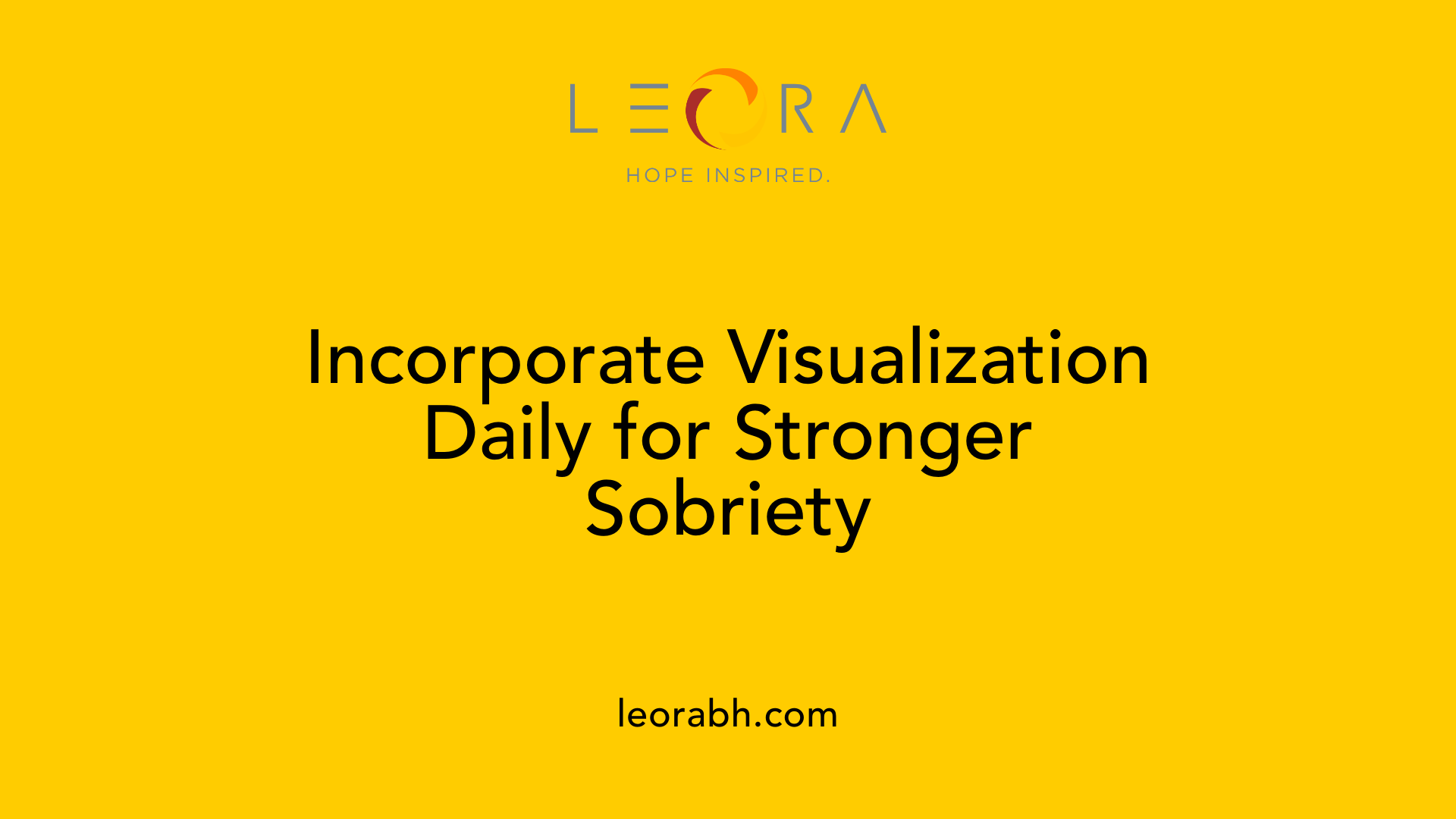How to Use Visualization in Addiction Recovery
Harnessing the Power of Mental Imagery for Lasting Sobriety
Unlocking Recovery Through Visualization Techniques
Visualization is a potent mental rehearsal tool that leverages creative imagination to foster recovery from addiction. When used effectively, it aligns thoughts, emotions, and behaviors to support lasting sobriety and emotional resilience. This article explores how visualization can be integrated into addiction treatment, provides practical exercises, and examines scientific insights underpinning its efficacy.
Understanding the Science Behind Visualization in Recovery

What are the benefits of using visualization in addiction treatment?
Visualization is a powerful mental tool in addiction recovery, offering numerous benefits that support the healing process. It helps strengthen motivation, enabling individuals to vividly imagine a life free from addiction, which reinforces their commitment to sobriety.
By creating mental images of positive outcomes, individuals can reduce cravings and manage triggers more effectively. This practice boosts confidence and self-efficacy, giving them a sense of control over their recovery journey.
Moreover, visualization enhances problem-solving skills and emotional regulation. Techniques such as vision boards, affirmations, and engaging all five senses make these mental images more vivid and impactful. Collectively, these benefits foster resilience, improve mental outlook, and align thoughts and behaviors, making lasting sobriety more attainable.
In sum, visualization not only motivates but also equips individuals with the mental tools needed to navigate challenges, maintain focus, and build a healthier lifestyle.
How does visualization work in therapy and healing contexts?
In therapeutic settings, visualization influences emotional and physical states by creating mental images that promote well-being. It capitalizes on the brain’s neuroplasticity—the ability to reorganize neural pathways—allowing imagined experiences to produce real neurological changes.
For example, guided imagery and mental rehearsal involve mentally simulating positive scenarios, which can help reduce stress, alleviate cravings, and foster relaxation. These practices engage neural circuits similar to actual experiences, strengthening them over time.
Visualization techniques like imagining oneself in calm settings or successfully overcoming challenges boost motivation and emotional resilience. When practiced regularly, they improve self-efficacy and help individuals manage negative emotions.
In addiction treatment, combined with mindfulness, deep breathing, and affirmations, visualization supports emotional balance and goal setting. When integrated with approaches such as Cognitive Behavioral Therapy (CBT) or Dialectical Behavior Therapy (DBT), it enhances overall treatment effectiveness. It promotes a sense of control and confidence, empowering individuals to take active roles in their recovery process.
What are the scientific foundations of visualization in brain functioning?
Scientific studies demonstrate that visualization activates similar brain regions as real actions. The visual cortex and associated neural pathways respond to mental imagery, creating physical and emotional reactions comparable to actual experiences.
Research indicates that the brain cannot distinguish fully between imagined and real events, which has profound implications for healing and behavior change. By repeatedly visualizing desired outcomes, individuals can forge stronger neural connections, making positive behaviors more accessible.
This neural engagement explains why visualization can reduce stress, improve mood, and increase motivation—effects critical in addiction recovery. It leverages neuroplasticity to reprogram thought patterns and emotional responses, fostering healthier mental habits.
Additionally, imagery-based practices have been linked to increased dopamine release, enhancing feelings of reward and motivation. Such neurochemical responses further reinforce behavioral change and recovery efforts.
How does mental rehearsal influence brain changes?
Mental rehearsal, closely related to visualization, involves repeatedly imagining performing specific actions or achieving goals. Brain mapping studies show that this mental practice produces changes similar to actual physical training.
Neuroimaging reveals that mental rehearsal activates neural circuits involved in movement, decision-making, and emotional regulation. Over time, this strengthens synaptic connections and increases brain plasticity.
In addiction recovery, mental rehearsal can help individuals visualize themselves resisting cravings or engaging in healthy activities, thereby preparing their brains for positive behavior. It diminishes anxiety related to feared situations and builds confidence.
Regular practice of mental rehearsal enhances problem-solving skills and emotional resilience, essential for navigating recovery challenges. This method effectively accelerates learning and habit formation by creating strong mental associations.
How does historical research support the effectiveness of mental imagery?
Historical research, such as Alan Richardson’s groundbreaking basketball experiment in 1967, demonstrates the efficacy of mental imagery. Richardson had basketball players practice free throws either physically, mentally, or via a combination of both.
Results showed that players who used mental imagery improved their free throw accuracy nearly as much as those who physically practiced. This early research provided strong evidence that mental rehearsal can produce tangible performance gains.
Since then, numerous studies across various fields—sports, medicine, and psychology—have confirmed that mental imagery enhances performance and learning. It underscores that brain activation through visualization can lead to real-world improvements.
In addiction recovery, this historical insight supports the use of visualization as a credible, scientifically backed tool. It highlights that mental practices can produce concrete changes in behavior and brain function, aiding individuals in their journey toward sobriety.
Practical Steps to Incorporate Visualization into Recovery Routines

Relaxation and mental focus techniques
Effective visualization begins with creating a calm mental state. Techniques such as deep breathing, progressive relaxation, and mindfulness meditation help quiet the mind and enhance focus. When individuals are relaxed, their brains are more receptive to vivid imagery and positive reinforcement. Incorporating short sessions of relaxation before visualization can increase the depth and clarity of mental images, making the experience more potent for recovery.
Creating vivid mental images and emotional engagement
Successful visualization involves imagining desired outcomes as if they are happening now. This includes seeing oneself in specific situations—like confidently declining a drink at a social event or managing stress without turning to substances. Engaging feelings and emotions bolsters the mental image, making it more real and impactful. When individuals connect emotionally with their visualization, they activate neural pathways similar to those used during actual experiences, reinforcing their motivation to stay sober.
Using sensory details to enhance visualizations
To make mental images more compelling, incorporate all five senses into the visualization process. For instance, imagine the sight of a peaceful beach, hear the gentle waves, feel the warmth of the sun, smell the salty air, and taste the fresh water. These sensory details create a multisensory experience that deepens immersion. The more vivid and detailed the mental simulation, the more it influences the subconscious mind, promoting positive behavior changes and reducing cravings.
Establishing consistent visualization habits
Consistency is crucial for effective outcomes. Developing a daily routine—perhaps in the morning or before bed—helps reinforce the mental images and associated emotions. Setting clear goals for each session, such as visualizing achieving a milestone in sobriety or managing stress calmly, fosters a sense of progression. Using tools such as visualization journals or guided imagery recordings can aid in maintaining regular practice. Over time, these habits build resilience, keep individuals focused, and strengthen their commitment to recovery.
Effective visualization exercises for recovery
Various exercises can be employed to support addiction recovery. Guided imagery, where a facilitator leads individuals through calming scenes or future success stories, helps reduce anxiety and build emotional strength. Creating vision boards—visual collages that depict goals and positive affirmations—serves as a physical reminder of desired outcomes. The
Integrating Visualization into Therapeutic Approaches
How can visualization techniques be used to strengthen emotional resilience and motivation during recovery?
Visualization is a powerful mental practice that can significantly bolster emotional resilience and motivation during addiction recovery. By vividly imagining successful future scenarios, individuals reinforce positive expectations and build confidence in their ability to change. This process involves creating detailed mental images that include sensory experiences—sights, sounds, and feelings—that simulate real-life success.
Practicing visualization helps individuals mentally prepare for possible challenges, such as cravings or stressful situations, by simulating effective coping strategies. For example, picturing oneself calmly navigating a social event where temptations might arise can reduce anxiety and increase perceived control.
Guided imagery exercises foster emotional regulation by promoting relaxation and reducing stress, which are critical during recovery. These practices also reinforce a sense of mastery over one's environment, leading to enhanced motivation to stay committed to sobriety.
When combined with therapies like mindfulness and cognitive-behavioral therapy (CBT), visualization enhances self-efficacy and helps reframe limiting beliefs about oneself and one's capabilities. Regular use, tailored to individual needs, creates neural pathways that support resilience, emotional stability, and sustained recovery efforts.
Enhancing Long-Term Recovery and Lifestyle Change

How does visualization work in therapy and healing contexts?
Visualization plays a powerful role in therapy and healing by allowing individuals to create vivid mental images that influence their emotional and physical states. When practiced regularly, visualization can reduce stress, alleviate symptoms related to mental health issues, and promote overall relaxation. It taps into the brain's neural pathways, which can change and strengthen just like physical practice, thanks to neuroplasticity. Techniques such as guided imagery, mental rehearsals, and envisioning positive future scenarios activate these pathways, reinforcing motivation, resilience, and healthier coping strategies.
This mental process helps to curb cravings, overcome negative beliefs, and manage emotional turbulence. When incorporated into comprehensive treatment plans—alongside methods like Cognitive Behavioral Therapy (CBT) and Dialectical Behavior Therapy (DBT)—visualization can enhance skill-building in emotional regulation, confidence, and self-efficacy. Its ability to shape positive thoughts and behaviors makes it an essential component in the healing journey, supporting not only immediate recovery but also long-term well-being.
How can visualization techniques be used to sustain sobriety and foster a purposeful life?
Using visualization to sustain sobriety involves more than just imagining a sober life. It entails regularly creating mental images of achieving meaningful goals, engaging in fulfilling activities, and building healthy relationships. When individuals vividly picture their future success, they activate positive neurochemical responses that reinforce their commitment to sobriety.
Visualizing overcoming daily challenges—such as social pressures or emotional triggers—equips individuals with mental strategies to handle real-life situations with resilience. This mental rehearsal acts as a preemptive defense against relapse by strengthening the brain’s ability to respond effectively to triggers.
In addition, visualizations of a purposeful life involving career ambitions, personal growth, or family happiness serve to deepen motivation. Routine practice of these mental images instills hope, aligns daily actions with core values, and creates a motivational roadmap. Combining visualization with mindfulness and affirmations further enhances self-belief and emotional stability, making recovery more sustainable.
Maintaining visualization practices over time
Long-term success in recovery depends on consistent practice. Developing a dedicated routine—such as daily visualization sessions—helps embed this mental skill into daily life. Setting clear goals about what to visualize, including specific achievements or lifestyle changes, makes the imagery more powerful and relevant.
Choosing effective visualizations tailored to individual needs is essential. For example, some may focus on imagining social situations where they stay sober, while others might see themselves enjoying new hobbies or experiences free from addiction.
Practicing in relaxed states—often after meditation or deep breathing—maximizes the effectiveness of visualization. Using tools like guided imagery recordings, visualization apps, or journaling can support these practices.
Creating mental images of future success and lifestyle
Imagining oneself in future scenarios fosters a sense of hope and purpose. Visualizations of life after achieving sobriety—such as enjoying a healthy diet, engaging in physical activity, or traveling—help solidify motivation.
Creating detailed mental images that involve all senses makes these visions more believable and emotionally engaging. Smelling fresh air during a walk, hearing applause at a personal achievement, or feeling a sense of accomplishment all enhance the realism.
Through consistent practice, these mental images become part of an internal narrative that supports ongoing recovery and lifestyle enhancement.
Using visualization to overcome relapse triggers
Triggers—like stress, social situations, or emotional distress—pose significant threats to sobriety. Visualization offers a proactive approach by mentally rehearsing responses to such triggers.
For instance, imagining oneself in a tempting scenario but responding calmly and confidently can prepare the mind to handle real-life episodes. Visualizing oneself successfully navigating cravings reinforces resilience.
It’s also helpful to visualize seeking support or using coping skills when faced with triggers, which builds mental readiness.
Incorporating these scenarios into daily visualizations ensures that when triggers occur, the individual responds with a practiced, confident outlook. This mental preparedness can significantly lower the risk of relapse and promote lasting recovery.
Embracing Visualization for a Brighter Future
Incorporating visualization in addiction recovery is backed by scientific research and practical success stories. It enhances motivation, emotional resilience, and the ability to envision a future free from addiction. When used alongside traditional therapies like CBT, guided imagery, and mindfulness, visualization amplifies the healing process. Regular practice—whether through mental rehearsal, affirmations, or vision boards—strengthens neural pathways crucial for lasting change. As part of a comprehensive recovery plan, visualization empowers individuals to see and achieve their best possible future, fostering hope and perseverance on the path to sobriety.
References
- Using Visualizations and Affirmations to Support Recovery
- The Power of Visualization in Addiction Recovery
- What Is Visualization? How To Visualization Towards Recovery
- Visualization for Mental Health & Addiction Treatment
- The Power of Visualization in Sober Living: Tips for Self-Motivation
- Creative Visualization | The Sanctuary at Sedona
- Guided Imagery Therapy: Core Principal, Techniques, Benefits, and ...
- How You Can Create a Creative Visualization for Recovery
- Overcome Addiction With Visualization | Alec Peer - Insight Timer
- Using Visualizations and Affirmations to Support Recovery
Find Your Inner Light
Related Articles
Schedule an Assessment
Leora Behavioral Health provides comprehensive treatment services, including ambulatory detox, mental health IOP, and SUD IOP, to support your journey toward lasting recovery.
Our caring team will guide you through the admissions process and create a personalized treatment plan tailored to your unique needs. We welcome walk-ins. If you or a loved one is struggling, reach out today. We’re here to help.


.svg)




.svg)
.svg)
.svg)
.svg)
